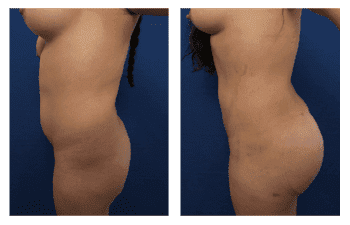

This 36-year-old female demonstrates high-definition liposuction of the lateral thighs, flanks, and lower back, with fat grafting to the lateral buttocks and hip and buttocks implants to the central buttocks.
Buttock implant risks are several and become a concern to prospective patients who do not possess adequate fat for a Brazilian Buttock Lift but desire increasing buttock size. Other patients may desire maximum buttock projection of the central butt that is not attainable with fat grafting alone. Buttock enhancement surgery risks have been well documented, including implant extrusion and infection.
Implant extrusion
- Implant extrusion is probably the most concerning buttock implant risk, with nationally reported rates nearing 10 to 20%. This buttock implant risk has likely lessened in the last few years as implant placement position has been converted from above the major gluteus muscle to inside the muscle. Safe buttock implant augmentation requires intimate knowledge of the gluteus major muscle size and shape. The secret to avoiding this buttock implant risk is to select a buttocks implant that fits comfortably within this muscle. The difficulty with this decision-making is that patients will often desire a larger implant that is too large for their muscles. Unfortunately, using an implant larger than the major gluteus width will result in the implant extruding first out of the muscle; this will immediately create a contour deformity as the edge of the muscle will be visible through the lateral buttock’s skin. More concerning is that once the implant tears out of the muscle, it will inevitably force its way out of the skin incision line resulting in implant extrusion.
- Implant infection. Implant infection is a buttock implant risk that can occur in any surgery where foreign material is implanted in the body. However, implant infection is intuitively more of a concern since the incision line is near your anus. As such several intraoperative precautions are taken to ensure that contamination is avoided. First, a double-prepping protocol is used to ensure that the area of the planned incision is not cross-contaminated. In addition, the planned implant pocket and the implant itself are irrigated in an antibiotic solution before placement. Finally, a minimal touch technique is used to handle the implant, meaning that only the surgeon is allowed to handle the implant. Postoperative precautions are also used to minimize the risk of infection, including postoperative antibiotics as well as teaching patients appropriate wiping techniques to keep the incision lines sterile.
Avoiding Buttock Implant Risks
With the proper surgical design, implant selection, and operative precautions, buttock enhancement surgery risks can be minimized. The placement of butt implants includes several potential risks that may increase the risk of complications. Appropriate implant selection is a critical component. The other precaution is ultrasound guidance when the butt implant augmentation is combined with a Brazilian Butt lift utilizing fat transfer. The use of ultrasound guidance assistance will not only minimize the risk of inadvertently grafting fat near the implant but also reduce the risk of fat embolism. This popular procedure for buttock augmentations can be concerned a safe surgical procedure when precautions are taken. Butt implant procedures today can be done safely by taking active steps to minimize risks of potential complications.

